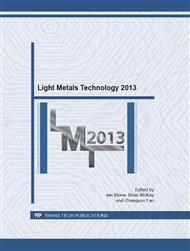p.788
p.793
p.798
p.803
p.808
p.813
p.818
p.823
p.827
Plasma Electrolytic Oxidation and Characterization of Spark Plasma Sintered Magnesium/Hydroxyapatite Composites
Abstract:
Magnesium (Mg)/hydroxyapatite (HA) (10 wt.% and 20 wt.%) composites were prepared by using pure Mg and as synthesized HA powders using the spark plasma sintering (SPS) method. The objective of the present study is to improve the corrosion resistance of spark plasma sintered Mg/HA composites and to ensure that the degradation time of these composites match with that of bone remodeling. Mg and HA powders were ball milled for 2 h and spark plasma sintered at a temperature of 475 °C and pressure of 40 MPa in vacuum. The sintered compacts were further treated by plasma electrolytic oxidation (PEO) in order to improve the corrosion resistance. The structural, microstructural and morphological studies were done using X-ray diffraction, optical microscopy and scanning electron microscopy, respectively. The corrosion resistance of as-sintered and PEO treated Mg/HA composites was studied by potentiodynamic polarization test in a 7.4 pH simulated body fluid (SBF) environment. The corrosion test results of as-sintered composites showed that the corrosion resistance decreases with the increase in percentage of HA in the composite. However, the PEO treated Mg/HA composites have shown delayed onset of degradation. Therefore, it can be hypothesized that the PEO treated Mg/HA composites would serve as bioactive and biodegradable orthopedic implant materials with low corrosion rates.
Info:
Periodical:
Pages:
827-831
Citation:
Online since:
July 2013
Price:
Сopyright:
© 2013 Trans Tech Publications Ltd. All Rights Reserved
Share:
Citation:


